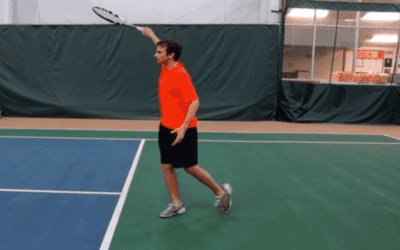Today’s article is going to be about the tennis forehand technique. Most players will get lessons from coaches showing them how Roger Federer’s arm is straight on the forehand.
If you can get your arm straight on your tennis forehand like Roger Federer, that is great. The problem is that most players will never be able to do that. Then, don’t worry if you cannot get your arm straight.
As a former professional tennis player, I had a very good forehand with my arm bent during contact. In fact, there are other professional players like Jack Sock whose tennis forehand technique is similar to mine.
Hence, I’ll share a great tip to help you develop a powerful forehand even with a bent arm at contact.
Tennis Forehand Technique Tip

Many tennis players are trying to straighten their arm on their forehand, which actually creates more tension. However, I think that it’s more important to be relaxed.
Instead of physically making your arm go straight at contact on the forehand, you can create the “feeling” of having a straight arm. Thus, you can create proper space, which is one of the keys for having a great first move on your forehand.
By “feeling” a straight arm even though it will most likely still be bent at contact, you won’t feel as close to the ball. Hence, just ensure that your arm feels relaxed when you practice this little known tip.
To summarise, focus on being relaxed with your arm as you swing and make contact with the ball. If your arm is bent, that’s okay as long as you have the proper spacing. That will definitely make a huge difference on your tennis forehand technique.
By Jeff Salzenstein, Founder Tennis Evolution.
Jeff is a former top 100 ATP player and USTA high performance coach committed to helping players and coaches all over the world improve.
P.S. – Ready to take your forehand to the next level? Click here to get a free membership inside the Tennis Evolution App. Learn the exact step-by-step system that has transformed the games of thousands of players worldwide.
12 Comments
Submit a Comment
You must be logged in to post a comment.



great video!, I think its important for people to realize that certain things like the “straight arm” forehand, are unique almost unconventional “weird” approaches to hitting the ball. Think about how McEnroe used to volley? very open stance almost casual somewhat strange approach to the volley, but yet – for sure it was the best volley in the world. Same with the Rafa and Fed forehands, if you watch slow mo footage, they are completely straight at contact with the fh – which is truly strange, but yet, best in the word. However, if you look at all the top 100 guys on ATP tour, my guess is maybe 5%-8% or so actually use the straight arm forehand. That is how rare this technique is IMO even among the top 100 ATP guys. Forget the straight arm and use the double bend fh like most people do (like most ATP players do) – unless you are Fed or Rafa 🙂 I suggest they continue using it, since Im sure they are reading my post 🙂
Great comment, Andy! I agree with you.
Dear Jeff, In my opinion, the secret of the powerful forehand of Federer comes mainly from the very relaxed arm and the delayed wrist snap which makes the racket head super fast. It is therefore not the straight arm bent arm issue I think. Nevertheless I agree with your recommendation to avoid the straight arm forehand. Such an extremely delayed wrist snap can result in lots of errors. It takes lots of regular practice to develop it to a reliable weapon and a no-no for the weekend warrior. Regards, Tennisnut
You make a very good point, tennisnut. Thanks for sharing.
Hi Jeff,
On my 2 handed backhand both arms are straight. I have tried to adjust this knowing that it is easier to saty relaxed and generate spin with bent arms, but I keep subconsciously switching back to straight. Since I am trying to play at a higher level (Top D3 College) is it worth it to put the time in to make the switch, or is it not an important factor in the quality of the shot? Thank you so much for the help
I would probably stay with the straight arms and model Agassi’s backhand. Easier to stay with what is natural.
Interesting this post has just come up i just started the straight arm forehand a few days ago it definitely allows you to add more punch and spin to the ball but is 3 times harder to get right. I definitely believe it to be more superior to the double bend. Even in the statistics of Roland Garros French Open Nadal only had his Ball RPM clocked at 1000 higher than Federer but it was interesting because Federer had the 2nd highest RPM and supposedly uses an Eastern Grip forehand. Hmm, i wonder if that could be in relation to their straight arms.
Doesn’t Del Porto also uses this technique, his forehands looked pretty straight to me.
Excellent posts Jeff, you are also popular here in Asia.
Hi Jeff, Yes the straight arm forehand seems to create big power but might be challenging for most players.
Thanks for letting me know that Asia loves JST:)
Hi Jeff: I agree that having a relaxed arm is important. I suspect that the reason most of the top players have a bent arm on their forehand is because they also use a two-handed backhand. On the backhand side for two-handers, the contact point (assuming good extension of the arms) is closer to the body compared to that for one-handers (full extension of the right arm) where the contact point is further out. However, on the forehand, assuming a straight arm at contact, the contact point for the one-handed forehand is the same for those with two and one-hand backhands. I think it is difficult for the brain to process this difference in body-ball spacing on the backhand and forehand sides, especially for two-handers. My guess is that the difference in spacing at contact between the single-handed backhand and single-handed forehand is very small, which suggests that someone like Federer has less of a problem with the straight arm forehand compared to most players with two-handed backhands. Nadal is an exception I think, so perhaps the brain can be trained to recognise this difference. While a bent but relaxed arm on the forehand works well, a bent arm on the single-handed backhand at contact can cause problems with consistency and power, and may result in injuries to the arm (elbow).
Thank you for the comment, Nagraj.
Thanks for this, Jeff. I love the great quality of the video and the simplicity of the message. Keep up the great effort. Beth and I just one our first pretty big tournament and we sure to have gratitude for all we have learned from you, Jeff Greenwald, Jim Loehr and so many other members of our guru community that make a difference. Our mechanics, spirits, mental, emotional and our physical components held up nicely to the competition over the tournament. It is fun to win. It feels like validation for all the hard work and energy.
Your help was a large piece of this win. Thank you Jeff.
Thank you, Jeff. It’s always an honor to help you. You are such a passiaonte student and mentor.